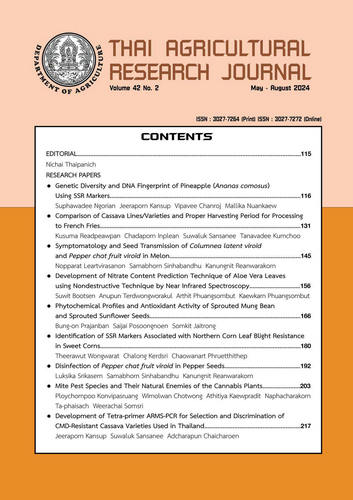Disinfection of Pepper chat fruit viroid in Pepper Seeds
DOI:
https://doi.org/10.14456/thaidoa-agres.2024.16Keywords:
hot water treatment, dry heat treatment, seed viroid detection, seed transmissionAbstract
Pepper chat fruit viroid (PCFVd) can cause disease in pepper. This disease can be transmitted via seeds and mechanical means. The global pepper seed trade is an important channel for PCFVd dissemination from country to country. The effectiveness of seed disinfection methods for PCFVd ranging from chemical to physical ones was evaluated. The methods using sodium hypochlorite 3%, sodium bicarbonate 10%, hydrochloric acid 0.5 N, trisodium phosphate 10%, hot water and dry heat treatment in combinations at different temperatures and time periods were tested in pepper seed varieties P-74 and P-TV infected with PCFVd 100%. After treatment, the infection rate was inspected by the reverse transcription-polymerase chain reaction technique on the whole seeds, seed coats and seedlings and the germination rates were determined. The results showed that soaking pepper seeds in 50°C hot water for 25 min followed by 72°C dry heat for 24 hours was the best treatment regime. It could get rid of 100% PCFVd while the germination rates remained at 96-99%. This result can be used as a recommendation for seed disinfection for PCFVd.
References
สำนักควบคุมพืชและวัสดุการเกษตร. 2566. ข้อมูลการนำเข้าและส่งออกเมล็ดพันธุ์ควบคุมเพื่อการค้า ปี 2566. แหล่งที่มา: https://www.doa.go.th/ard/?page_id=1443. สืบค้น: 20 เมษายน 2567.
Antignus, Y., O. Lachman and M. Pearlsman, 2007. Spread of Tomato apical stunt viroid (TASVd) in greenhouse tomato crops is associated with seed transmission and bumble bee activity. Plant Disease. 91(1): 47-50.
Card, S.D., M.N. Pearson and G.R.G. Clover. 2007. Plant pathogens transmitted by pollen. Australasian Plant Pathology. 36: 455–461.
Chambers, G.A., A.M. Seyb, J. Mackie, F.E. Constable, B.C. Rodoni, D. Letham, K. Davis and M.J. Gibbs. 2013. First report of Pepper chat fruit viroid in traded tomato seed, an interception by Australian Biosecurity. Plant Disease. 97: 1386.
Córdoba-Sellés, M. C., A. García-Rández, A. Alfaro-Fernández and C. JordáGutiérrez. 2007. Seed transmission of Pepino mosaic virus and efficacy of tomato seed disinfection treatments. Plant Disease. 91: 1250-1254.
Garnsey, S.M. and R. Whidden. 1971. Decontamination treatments to reduce the spread of Citrus excortis virus (CEV) by contaminated tools. Proceedings of the Florida State Horticultural Society. 84: 63-67.
Hammond, R.W. 2017. Seed, pollen, and insect transmission of viroids. pp. 521–529. In: Viroids and Satellites. A. Hadidi and R. Flores (eds). Elsevier Inc.
Hammond, R.W. and R.A. Owens. 2006. Viroids: new and continuing risks for horticultural and agricultural crops. APS Features. Available at: https://doi.org/ 10.1094/APSnetFeature-2006-1106. Accessed: January 19, 2023.
International Plant Genetic Resources Institute (IPGRI). 1995. Descriptors for Capsicum (Capsicum spp.). Available at: https://cgspace.cgiar.org/items/ef0f3bcd-4878-4025-90ed-098a4c1b2918. Accessed: February 1, 2024.
ISTA. 2016. International Rules for Seed Testing 2016. The International Seed Testing Association (ISTA) Zürichstrasse 508303, Bassersdorf CH - Switzerland. 16. Available at: https://www.merconet.eu/files/Seed Sampling_ISTA.pdf. Accessed: October 10, 2023.
Jeffries, C. and J. Tina. 2004. Protocol for the Diagnosis of Quarantine Organism: Potato spindle tuber viroid (PSTVd). Scottish Agricultural Science Agency, East Craigs, Edinburgh, United Kingdom.
Kungwon, P., C. Netwong, S. Porsoongnoen and K. Reanwarakorn. 2022. Chrysanthemum stunt viroid as a protective viroid isolate against Columnea latent viroid and Pepper chat fruit viroid in tomato plants. International Journal of Agricultural Technology. 18(4): 1601-1618.
Matsuura, S., Y. Matsushita, T. Usugi and S. Tsuda. 2010. Disinfection of tomato Chlorotic dwarf viroid by chemical and biological agents. Crop Protection. 29(10): 1157-1161.
Matsushita, Y and S. Tsuda. 2016. Seed transmission of Potato spindle tuber viroid, Tomato chlorotic dwarf viroid, Tomato apical stunt viroid and Columnea latent viroid in horticultural plants. European Journal of Plant Pathology. 145: 1007–1011.
Nakamura, H. 1982. Effects of dry heat treatment for seed disinfection on germination in vegetables. Japan Agricultural Research Quarterly. 15: 243-247.
Olivier, T., V. Sveikauskas, S. Grausgruber-Groger, M. VirscekMarn, F. Faggioli, M. Luigi, E. Pitchugina and V. Planchon. 2015. Efficacy of five disinfectants against Potato spindle tuber viroid. Crop Protection. 67: 257-260.
R core team. 2021. R: A language and environment for statistical computing. Available at: https://www.r-project.org/. Accessed: October 10, 2023
Reanwarakorn, K., S. Klinkong and J. Porsoongnurn. 2011. First report of natural infection of Pepper chat fruit viroid in tomato plants in Thailand. New Disease Reports. 24(6): 6.
Serio, F.D., R. Flores, J.Th.J. Verhoeven, S.F. Li, V. Pallás, J.W. Randles, T. Sano, G. Vidalakis and R.A. Owens. 2014. Current status of viroid taxonomy. Archives of Virology. 159: 3467–3478.
Singh, R.P., A. Boucher and T.H. Somerville. 1989. Evaluation of chemicals for disinfection of laboratory equipment exposed to Potato spindle tuber viroid. American Journal of Potato Research. 66: 239-245.
Sombat, S. 2019. Multiplex Real-time RT-PCR and Seed Disinfection of Pepper chat fruit viroid and Columnea latent viroid in Tomato Seed. Thesis in Doctor of Philosophy of Science, Program in Plant Pathology. Kasetsart University. 82 p.
Verhoeven, J.T.J., C.C.C. Jansen, J.W. Roenhorst, R. Flores and M. de la Peña. 2009. Pepper chat fruit viroid: Biological and molecular properties of a proposed new species of the genus Pospiviroid. Virus Research. 144: 209-214.
Verhoeven, J.T.J., H.M.S. Koenraadt, A. Jodlowska, L. Hüner and J.W. Roenhorst. 2020. Pospiviroid infection in Capsicum annuum: Disease symptom and lack of seed transmission. European Journal of Plant Pathology. 156: 21-29.
Verhoeven, J. T. J., M. Botermans, R. Schoen, H. Koenraadt and J. W. Roenhorst. 2021. Possible overestimation of seed transmission in the spread of pospiviroids in commercial pepper and tomato crops based on large-scale grow-out trials and systematic literature review. Plants. 10(8): 1707.
Wang, C.H. 2022. Evaluation of seed re-treatment efficiency for viroid positive seed lots. World Vegetable Center. Available at: https://worldveg.tind.io/record/74713. Accessed: December 9, 2023.
Yanagisawa, H., Y. Shiki, Y. Matsushita, M. Ooishi, N. Takaue and S. Tsuda. 2017. Development of a comprehensive detection and identification molecular based system for eight pospiviroids. European Journal of Plant Pathology. 149: 11–23.
Downloads
Published
How to Cite
Issue
Section
License
Copyright (c) 2024 Thai Agricultural Research Journal

This work is licensed under a Creative Commons Attribution-NonCommercial-NoDerivatives 4.0 International License.
Thai Agricultural Research Journal



